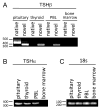A novel thyroid stimulating hormone beta-subunit isoform in human pituitary, peripheral blood leukocytes, and thyroid
- PMID: 19364510
- PMCID: PMC2689139
- DOI: 10.1016/j.ygcen.2009.04.006
A novel thyroid stimulating hormone beta-subunit isoform in human pituitary, peripheral blood leukocytes, and thyroid
Erratum in
- Gen Comp Endocrinol. 2009 Nov-Dec;164(2-3):130
Abstract
Thyroid stimulating hormone (TSH) is produced by the anterior pituitary and is used to regulate thyroid hormone output, which in turn controls metabolic activity. Currently, the pituitary is believed to be the only source of TSH used by the thyroid. Recent studies in mice from our laboratory have identified a TSHbeta isoform that is expressed in the pituitary, in peripheral blood leukocytes (PBL), and in the thyroid. To determine whether a human TSHbeta splice variant exists that is analogous to the mouse TSHbeta splice variant, and whether the pattern of expression of the splice variant is similar to that observed in mice, PCR amplification of RNAs from pituitary, thyroid, PBL, and bone marrow was done by reverse-transcriptase PCR and quantitative realtime PCR. Human pituitary expressed a TSHbeta isoform that is analogous to the mouse TSHbeta splice variant, consisting of a 27 nucleotide portion of intron 2 and all of exon 3, coding for 71.2% of the native human TSHbeta polypeptide. Of particular interest, the TSHbeta splice variant was expressed at significantly higher levels than the native form or TSHbeta in PBL and the thyroid. The TSHalpha gene also was expressed in the pituitary, thyroid, and PBL, but not the BM, suggesting that the TSHbeta polypeptide in the thyroid and PBL may exist as a dimer with TSHalpha. These findings identify an unknown splice variant of human TSHbeta. They also have implications for immune-endocrine interactions in the thyroid and for understanding autoimmune thyroid disease from a new perspective.
Figures




References
-
- Klein JR, Wang HC. Characterization of a novel set of resident intrathyroidal bone marrow-derived hematopoietic cells: potential for immune-endocrine interactions in thyroid homeostasis. J Exp Biol. 2004;207:55–65. - PubMed
-
- Kruger TE, Blalock JE. Cellular requirements for thyrotropin enhancement of in vitro antibody production. J Immunol. 1986;137:197–200. - PubMed
Publication types
MeSH terms
Substances
Grants and funding
LinkOut - more resources
Full Text Sources
Molecular Biology Databases
Research Materials

